Residual Properties of Geopolymer Concrete for Post-Fire Evaluation of Structures
Abstract
:1. Introduction
2. Materials and Methods
2.1. Materials
2.1.1. Binder
2.1.2. Filler
2.1.3. Alkaline Activator
2.2. Methods
2.2.1. Casting & Curing
2.2.2. Testing
2.2.3. Heating Program
2.2.4. Crack Width Measurement
2.2.5. Scanning Electron Microscope
3. Results
3.1. Compressive Strength (CS)
3.2. Sorptivity
3.3. Mass Loss
3.4. Crack Pattern
3.5. Residual CS
3.6. Microstructural Investigation
4. Discussion of the Results with Other Published Data
4.1. Following Are the Assumptions and Limitations Made during the Experimental and Analytical Investigation
- The comparison between the performance of binary blended mix is based on a specific mix proportion of materials used for blending, and the results may vary for other combinations.
- The decline in CS of concrete after temperature exposure is found for all samples tested, but there may be variations due to factors such as mix composition, curing conditions, and testing methods.
- The results are based on a limited proportion of samples, and the influence of various parameters on the performance of concrete needs further investigation.
4.2. Future Research Directions and Recommendations Based on the Findings of This Study Could Include
- Conducting more extensive experiments with a larger number of samples to establish a more reliable database to improve the statistical significance of the results through software simulation and modelling.
- Investigation on the influence of various parameters, such as precursor type, alkaline activator, activator concentration, reinforcement ratio, intensity and duration of heating, on the performance of concrete.
- Exploring the potential usage of other Supplementary cementitious materials, such as rice husk ash, bagasse ash and silica fume, into the mix to study their effect on the strength and durability of concrete.
- Investigation on the long-term behavior of concrete under different environmental conditions, such as freeze-thaw cycles and chloride ingress.
- Conducting a comparative life cycle assessment (LCA) of concrete with other sustainable construction materials to gain a better understanding of their environmental impact to identify potential areas for improvement.
- Investigating the potential of using recycled materials in the production of concrete to enhance their sustainability credentials.
5. Conclusions
Author Contributions
Funding
Institutional Review Board Statement
Data Availability Statement
Conflicts of Interest
References
- Zhang, Q.; Feng, P.; Shen, X.; Lu, J.; Ye, S.; Wang, H.; Ling, T.C.; Ran, Q. Utilization of Solid Wastes to Sequestrate Carbon Dioxide in Cement-Based Materials and Methods to Improve Carbonation Degree: A Review. J. CO2 Util. 2023, 72, 102502. [Google Scholar] [CrossRef]
- Cheng, Y.; Qi, R.; Hou, J.; Huang, Q. Feasibility Study on Utilization of Copper Tailings as Raw Meal and Addition for Low Carbon Portland Cement Production. Constr. Build. Mater. 2023, 382, 131275. [Google Scholar] [CrossRef]
- Li, K.; Han, J.; Wang, S.; Lian, H.; Xiong, J.; Wang, J.; Fan, Z.; Xu, L.; Zhu, H. Long-Term Performance of Structural Concretes in China Southeast Coastal Environments Exposed to Atmosphere and Chlorides. Cem. Concr. Res. 2023, 164, 107064. [Google Scholar] [CrossRef]
- Aksoylu, C.; Hakamy, A.; Hakan, M. Case Studies in Construction Materials Experimental Investigation and Analytical Prediction of Flexural Behaviour of Reinforced Concrete Beams with Steel Fibres Extracted from Waste Tyres. Case Stud. Constr. Mater. 2023, 19, e02227. [Google Scholar] [CrossRef]
- Al-Rousan, E.T.; Khalid, H.R.; Rahman, M.K. Fresh, Mechanical, and Durability Properties of Basalt Fiber-Reinforced Concrete (BFRC): A Review. Dev. Built Environ. 2023, 14, 100155. [Google Scholar] [CrossRef]
- Hardjito, D.; Wallah, S.E.; Sumajouw, D.M.J.; Rangan, B.V. On the Development of Fly Ash-Based Geopolymer Concrete. ACI Mater. J. 2004, 101, 467–472. [Google Scholar] [CrossRef]
- Hardjito, D.; Wallah, S.E.; Sumajouw, D.M.J.; Rangan, B.V. Fly Ash-Based Geopolymer Concrete. Aust. J. Struct. Eng. 2016, 7982, 77–86. [Google Scholar] [CrossRef]
- Sumajouw, M.D.J.; Rangan, B.V. Low-Calcium Fly Ash-Based Geopolymer Concrete: Reinforced Beams and Columns. Ph.D. Thesis, Curtin University, Perth, Australia, 2006. [Google Scholar]
- Sumajouw, D.M.J.; Hardjito, D.; Wallah, S.E.; Rangan, B.V. Fly Ash-Based Geopolymer Concrete: Study of Slender Reinforced Columns. J. Mater. Sci. 2007, 42, 3124–3130. [Google Scholar] [CrossRef]
- Nath, P.; Sarker, P.K.; Rangan, V.B. Early Age Properties of Low-Calcium Fly Ash Geopolymer Concrete Suitable for Ambient Curing. Procedia Eng. 2015, 125, 601–607. [Google Scholar] [CrossRef]
- Turner, L.K.; Collins, F.G. Carbon Dioxide Equivalent (CO2-e) Emissions: A Comparison between Geopolymer and OPC Cement Concrete. Constr. Build. Mater. 2013, 43, 125–130. [Google Scholar] [CrossRef]
- Alnahhal, M.F.; Alengaram, U.J.; Jumaat, M.Z.; Abutaha, F.; Alqedra, M.A.; Nayaka, R.R. Assessment on Engineering Properties and CO2 Emissions of Recycled Aggregate Concrete Incorporating Waste Products as Supplements to Portland Cement. J. Clean. Prod. 2018, 203, 822–835. [Google Scholar] [CrossRef]
- Manjunatha, G.S.; Radhakrishna; Venugopal, K.; Maruthi, S.V. Strength Characteristics of Open Air Cured Geopolymer Concrete. Trans. Indian Ceram. Soc. 2014, 73, 149–156. [Google Scholar] [CrossRef]
- Garcia-Lodeiro, I.; Palomo, A.; Fernández-Jiménez, A. An Overview of the Chemistry of Alkali-Activated Cement-Based Binders; Woodhead Publishing Limited: Sawston, UK, 2015; ISBN 9781782422884. [Google Scholar]
- Duxson, P.; Provis, J.L.; Lukey, G.C.; Deventer, J.S.J. Van The Role of Inorganic Polymer Technology in the Development of ‘Green Concrete’. Cem. Concr. Res. 2007, 37, 1590–1597. [Google Scholar] [CrossRef]
- Rashad, A.M. Metakaolin as Cementitious Material: History, Scours, Production and Composition-A Comprehensive Overview. Constr. Build. Mater. 2013, 41, 303–318. [Google Scholar] [CrossRef]
- Singh, N.B.; Middendorf, B. Geopolymers as an Alternative to Portland Cement: An Overview. Constr. Build. Mater. 2020, 237, 117455. [Google Scholar] [CrossRef]
- Shilar, F.A.; Ganachari, S.V.; Patil, V.B.; Nisar, K.S.; Yahia, I.S. Evaluation of the Effect of Granite Waste Powder by Varying the Molarity of Activator on the Mechanical Properties of Ground. Polymers 2022, 14, 306. [Google Scholar] [CrossRef]
- Lee, W.K.W.; van Deventer, J.S.J. Chemical Interactions between Siliceous Aggregates and Low-Ca Alkali-Activated Cements. Cem. Concr. Res. 2007, 37, 844–855. [Google Scholar] [CrossRef]
- Mir, N.; Khan, S.A.; Kul, A.; Sahin, O.; Sahmaran, M.; Koc, M. Life Cycle Assessment of Construction and Demolition Waste-Based Geopolymers Suited for Use in 3-Dimensional Additive Manufacturing. Clean. Eng. Technol. 2022, 10, 100553. [Google Scholar] [CrossRef]
- Kuang, L.; Li, G.; Xiang, J.; Ma, W.; Cui, X. Effect of Seawater on the Properties and Microstructure of Metakaolin/Slag-Based Geopolymers. Constr. Build. Mater. 2023, 397, 132418. [Google Scholar] [CrossRef]
- Korniejenko, K.; Pławecka, K.; Kozub, B. An Overview for Modern Energy-Efficient Solutions for Lunar and Martian Habitats Made Based on Geopolymers Composites and 3D Printing Technology. Energies 2022, 15, 9322. [Google Scholar] [CrossRef]
- Managing, H.; Gangue, C. Mechanical Response of Geopolymer Foams to Heating-Managing Coal Gangue in Fire-Resistant Materials Technology. Energies 2022, 15, 3363. [Google Scholar] [CrossRef]
- Raj, S.R.; Arulraj, P.G.; Anand, N.; Balamurali, K.; Gokul, G. Influence of Various Design Parameters on Compressive Strength of Geopolymer Concrete: A Parametric Study by Taguchi Method. Int. J. Eng. Trans. B Appl. 2021, 34, 2351–2359. [Google Scholar] [CrossRef]
- IS 383; Coarse and Fine Aggregate for Concrete—Specification, New Delhi, India. Bureau of Indian Standards: New Delhi, India, 2016.
- IS 252; Caustic Soda—Specification. Bureau of Indian Standards: New Delhi, India, 2013.
- IS 381; Sodium Silicate—Specification. Bureau of Indian Standards: New Delhi, India, 1995.
- IS 516; Method of Tests for Strength of Concrete-Specifications, New Delhi, India. Bureau of Indian Standards: New Delhi, India, 2004.
- ASTM C 1585; Standard Test Method for Measurement of Rate of Absorption of Water by Hydraulic-Cement Concretes. Annual Book of ASTM Standards: Pennsylvania, PA, USA, 2004.
- ISO 834-1; Fire Resistance Tests—Elements of Building Construction—Part 1: General Requirements. BR Standard Instructions: Geneva, Switzerland, 1999.
- Cristelo, N.; Garcia-Lodeiro, I.; Rivera, J.F.; Miranda, T.; Palomo, Á.; Coelho, J.; Fernández-Jiménez, A. One-Part Hybrid Cements from Fly Ash and Electric Arc Furnace Slag Activated by Sodium Sulphate or Sodium Chloride. J. Build. Eng. 2021, 44, 103298. [Google Scholar] [CrossRef]
- Rashad, A.M. Lightweight Expanded Clay Aggregate as a Building Material—An Overview. Constr. Build. Mater. 2018, 170, 757–775. [Google Scholar] [CrossRef]
- Assi, L.; Carter, K.; Deaver (Eddie), E.; Anay, R.; Ziehl, P. Sustainable Concrete: Building a Greener Future. J. Clean. Prod. 2018, 198, 1641–1651. [Google Scholar] [CrossRef]
- Ismail, I.; Bernal, S.A.; Provis, J.L.; San Nicolas, R.; Hamdan, S.; Van Deventer, J.S.J. Modification of Phase Evolution in Alkali-Activated Blast Furnace Slag by the Incorporation of Fly Ash. Cem. Concr. Compos. 2014, 45, 125–135. [Google Scholar] [CrossRef]
- Panagiotopoulou, C.; Tsivilis, S.; Kakali, G. Application of the Taguchi Approach for the Composition Optimization of Alkali Activated Fly Ash Binders. Constr. Build. Mater. 2015, 91, 17–22. [Google Scholar] [CrossRef]
- Zannerni, G.M.; Fattah, K.P.; Al-Tamimi, A.K. Ambient-Cured Geopolymer Concrete with Single Alkali Activator. Sustain. Mater. Technol. 2020, 23, e00131. [Google Scholar] [CrossRef]
- Darvish, P.; Johnson Alengaram, U.; Soon Poh, Y.; Ibrahim, S.; Yusoff, S. Performance Evaluation of Palm Oil Clinker Sand as Replacement for Conventional Sand in Geopolymer Mortar. Constr. Build. Mater. 2020, 258, 120352. [Google Scholar] [CrossRef]
- Ahmed, H.U.; Mohammed, A.A.; Mohammed, A.S. The Role of Nanomaterials in Geopolymer Concrete Composites: A State-of-the-Art Review. J. Build. Eng. 2022, 49, 104062. [Google Scholar] [CrossRef]
- Danish, A.; Ozbakkaloglu, T.; Ali Mosaberpanah, M.; Salim, M.U.; Bayram, M.; Yeon, J.H.; Jafar, K. Sustainability Benefits and Commercialization Challenges and Strategies of Geopolymer Concrete: A Review. J. Build. Eng. 2022, 58, 105005. [Google Scholar] [CrossRef]
- Ansari, M.A.; Shariq, M.; Mahdi, F. Geopolymer Concrete for Clean and Sustainable Construction—A State-of-the-Art Review on the Mix Design Approaches. Structures 2023, 55, 1045–1070. [Google Scholar] [CrossRef]
- Sidhu, J.; Kumar, P. Development of Hydrophobicity in Geopolymer Composites-Progress and Perspectives. Constr. Build. Mater. 2023, 396, 132344. [Google Scholar] [CrossRef]
- Swathi, B.; Vidjeapriya, R. Influence of Precursor Materials and Molar Ratios on Normal, High, and Ultra-High Performance Geopolymer Concrete—A State of Art Review. Constr. Build. Mater. 2023, 392, 132006. [Google Scholar] [CrossRef]
- Ruan, S.; Yan, D.; Chen, S.; Jiang, F.; Shi, W. Process and Mechanisms of Multi-Stage Water Sorptivity in Hydrophobic Geopolymers Incorporating Polydimethylsiloxane. Cem. Concr. Compos. 2022, 128, 104460. [Google Scholar] [CrossRef]
- Zhu, Z.; Huo, W.; Sun, H.; Ma, B.; Yang, L. Correlations between Unconfined Compressive Strength, Sorptivity and Pore Structures for Geopolymer Based on SEM and MIP Measurements. J. Build. Eng. 2023, 67, 106011. [Google Scholar] [CrossRef]
- Mo, K.H.; Alengaram, U.J.; Jumaat, M.Z.; Liu, M.Y.J.; Lim, J. Assessing Some Durability Properties of Sustainable Lightweight Oil Palm Shell Concrete Incorporating Slag and Manufactured Sand. J. Clean. Prod. 2016, 112, 763–770. [Google Scholar] [CrossRef]
- Darvish, P.; Alengaram, U.J.; Alnahhal, A.M.; Poh, Y.S.; Ibrahim, S. Enunciation of Size Effect of Sustainable Palm Oil Clinker Sand on the Characteristics of Cement and Geopolymer Mortars. J. Build. Eng. 2021, 44, 103335. [Google Scholar] [CrossRef]
- Thanaraj, D.P.; Anand, N.; Arulraj, G.P. Post-Fire Damage Assessment and Capacity Based Modeling of Concrete Exposed to Elevated Temperature, International Journal of Damage Mechanics; Sage Publications: Newbury Park, CA, USA, 2019; ISBN 1056789519881. [Google Scholar]
- Buyondo, K.A.; Olupot, P.W.; Kirabira, J.B.; Yusuf, A.A. Optimization of Production Parameters for Rice Husk Ash-Based Geopolymer Cement Using Response Surface Methodology. Case Stud. Constr. Mater. 2020, 13, e00461. [Google Scholar] [CrossRef]
- Mathew, G.; Joseph, B. Flexural Behaviour of Geopolymer Concrete Beams Exposed to Elevated Temperatures. J. Build. Eng. 2018, 15, 311–317. [Google Scholar] [CrossRef]
- Shilar, F.A.; Ganachari, S.V.; Patil, V.B.; Nisar, K.S. Evaluation of Structural Performances of Metakaolin Based Geopolymer Concrete. J. Mater. Res. Technol. 2022, 20, 3208–3228. [Google Scholar] [CrossRef]
- Albidah, A.; Abadel, A.; Alrshoudi, F.; Altheeb, A.; Abbas, H.; Al-Salloum, Y. Bond Strength between Concrete Substrate and Metakaolin Geopolymer Repair Mortars at Ambient and Elevated Temperatures. J. Mater. Res. Technol. 2020, 9, 10732–10745. [Google Scholar] [CrossRef]
- Kanagaraj, B.; Anand, N.; Katherine, A.C.; Diana, A. Post-fire behavior of concrete containing nano-materials as a cement replacement material. Case Stud. Constr. Mater. 2023, 18, e02171. [Google Scholar] [CrossRef]
- Thanaraj, D.P.; Anand, N.; Arulraj, P. Experimental Investigation of Mechanical Properties and Physical Characteristics of Concrete under Standard Fire Exposure. J. Eng. Des. Technol. 2019, 17, 878–903. [Google Scholar] [CrossRef]
- Su, H.; Xu, J.; Ren, W. Mechanical Properties of Geopolymer Concrete Exposed to Dynamic Compression under Elevated Temperatures. Ceram. Int. 2016, 42, 3888–3898. [Google Scholar] [CrossRef]
- Mathews, M.E.; Anand, N.; Kodur, V.K.; Arulraj, P. The bond strength of self-compacting concrete exposed to elevated temperature. Proc. Inst. Civ. Eng.-Struct. Build. 2021, 174, 804–821. [Google Scholar] [CrossRef]
- Kanagaraj, B.; Lubloy, E.; Anand, N.; Hlavicka, V.; Kiran, T. Investigation of physical, chemical, mechanical, and microstructural properties of cement-less concrete–state-of-the-art review. Constr. Build. Mater. 2023, 365, 130020. [Google Scholar] [CrossRef]
- Jiang, X.; Xiao, R.; Zhang, M.; Hu, W.; Bai, Y.; Huang, B. A Laboratory Investigation of Steel to Fly Ash-Based Geopolymer Paste Bonding Behavior after Exposure to Elevated Temperatures. Constr. Build. Mater. 2020, 254, 119267. [Google Scholar] [CrossRef]
- Shaikh, F.U.A.; Hosan, A. Mechanical Properties of Steel Fibre Reinforced Geopolymer Concretes at Elevated Temperatures. Constr. Build. Mater. 2016, 114, 15–28. [Google Scholar] [CrossRef]
- Abdulkareem, O.A.; Mustafa Al Bakri, A.M.; Kamarudin, H.; Khairul Nizar, I.; Saif, A.A. Effects of Elevated Temperatures on the Thermal Behavior and Mechanical Performance of Fly Ash Geopolymer Paste, Mortar and Lightweight Concrete. Constr. Build. Mater. 2014, 50, 377–387. [Google Scholar] [CrossRef]
- Kong, D.L.Y.; Sanjayan, J.G. Damage Behavior of Geopolymer Composites Exposed to Elevated Temperatures. Cem. Concr. Compos. 2008, 30, 986–991. [Google Scholar] [CrossRef]
- Zhang, H.Y.; Kodur, V.; Qi, S.L.; Cao, L.; Wu, B. Development of Metakaolin-Fly Ash Based Geopolymers for Fire Resistance Applications. Constr. Build. Mater. 2014, 55, 38–45. [Google Scholar] [CrossRef]
- Zhang, H.Y.; Lv, H.R.; Kodur, V.; Qi, S.L. Comparative Fire Behavior of Geopolymer and Epoxy Resin Bonded Fiber Sheet Strengthened RC Beams. Eng. Struct. 2018, 155, 222–234. [Google Scholar] [CrossRef]
- Hussain, K.; Butt, F.; Alwetaishi, M.; Waqas, R.M.; Aslam, F.; Ibraheem, M.; Xulong, Z.; Ahmad, N.; Tufail, R.F.; Musarat, M.A.; et al. Effect of Quarry Rock Dust as a Binder on the Properties of Fly Ash and Slag-Based Geopolymer Concrete Exposed to Ambient and Elevated Temperatures. Appl. Sci. 2021, 11, 9192. [Google Scholar] [CrossRef]
- Özbayrak, A.; Kucukgoncu, H.; Aslanbay, H.H.; Aslanbay, Y.G.; Atas, O. Comprehensive Experimental Analysis of the Effects of Elevated Temperatures in Geopolymer Concretes with Variable Alkali Activator Ratios. J. Build. Eng. 2023, 68, 106108. [Google Scholar] [CrossRef]
- Zhang, H.; Kumar Sarker, P.; Wang, Q.; He, B.; Chandra Kuri, J.; Jiang, Z. Comparison of Compressive, Flexural, and Temperature-Induced Ductility Behaviours of Steel-PVA Hybrid Fibre Reinforced OPC and Geopolymer Concretes after High Temperatures Exposure. Constr. Build. Mater. 2023, 399, 132560. [Google Scholar] [CrossRef]
- Tayeh, B.A.; Zeyad, A.M.; Agwa, I.S.; Amin, M. Effect of Elevated Temperatures on Mechanical Properties of Lightweight Geopolymer Concrete. Case Stud. Constr. Mater. 2021, 15, e00673. [Google Scholar] [CrossRef]
- Tahwia, A.M.; Ellatief, M.A.; Bassioni, G.; Heniegal, A.M.; Elrahman, M.A. Influence of High Temperature Exposure on Compressive Strength and Microstructure of Ultra-High Performance Geopolymer Concrete with Waste Glass and Ceramic. J. Mater. Res. Technol. 2023, 23, 5681–5697. [Google Scholar] [CrossRef]
- Albidah, A.; Alqarni, A.S.; Abbas, H.; Almusallam, T.; Al-Salloum, Y. Behavior of Metakaolin-Based Geopolymer Concrete at Ambient and Elevated Temperatures. Constr. Build. Mater. 2022, 317, 125910. [Google Scholar] [CrossRef]
- Amin, M.; Elsakhawy, Y.; Abu el-hassan, K.; Abdelsalam, B.A. Behavior Evaluation of Sustainable High Strength Geopolymer Concrete Based on Fly Ash, Metakaolin, and Slag. Case Stud. Constr. Mater. 2022, 16, e00976. [Google Scholar] [CrossRef]
- Luo, Y.; Li, S.H.; Klima, K.M.; Brouwers, H.J.H.; Yu, Q. Degradation Mechanism of Hybrid Fly Ash/Slag Based Geopolymers Exposed to Elevated Temperatures. Cem. Concr. Res. 2022, 151, 106649. [Google Scholar] [CrossRef]
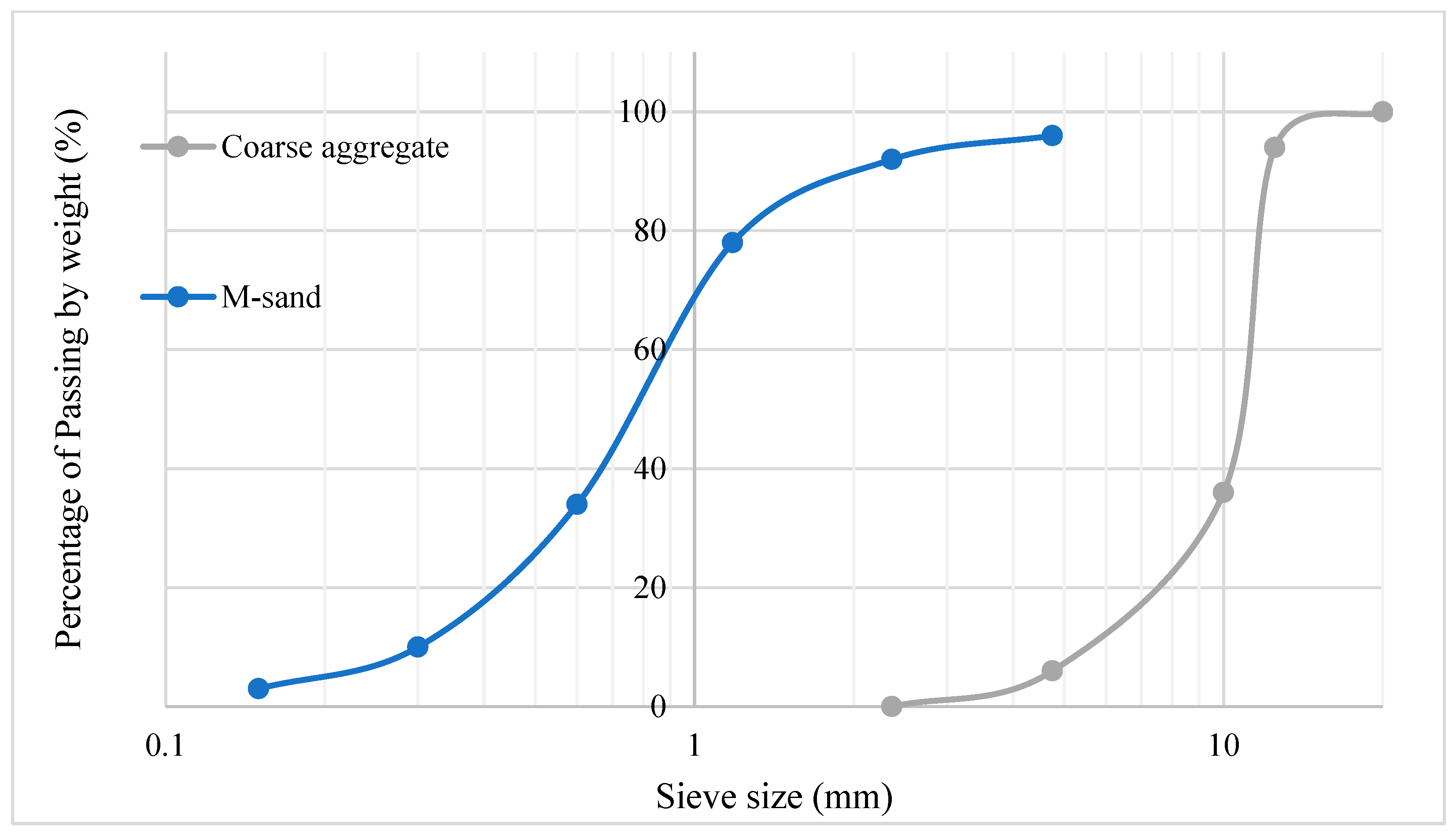


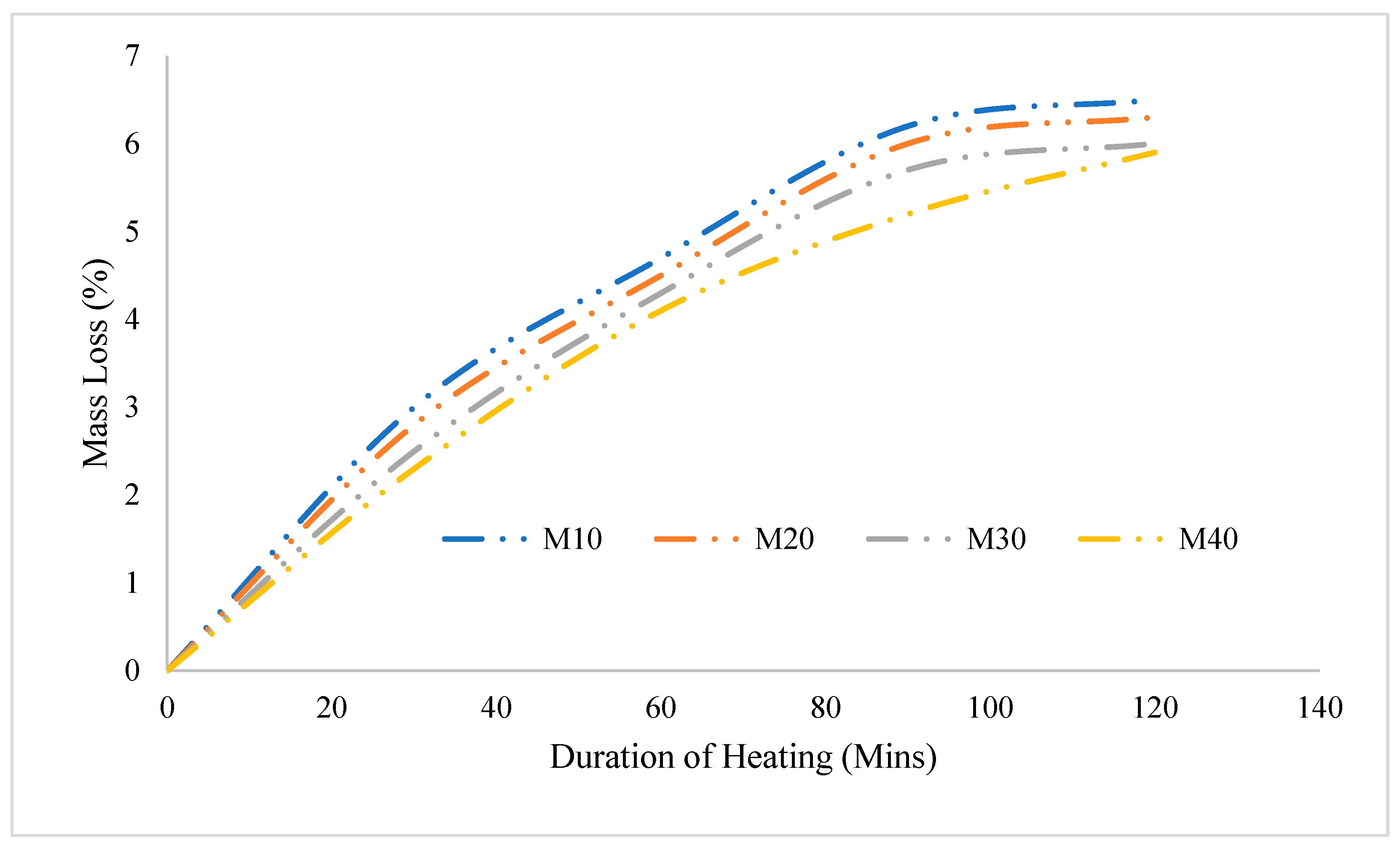

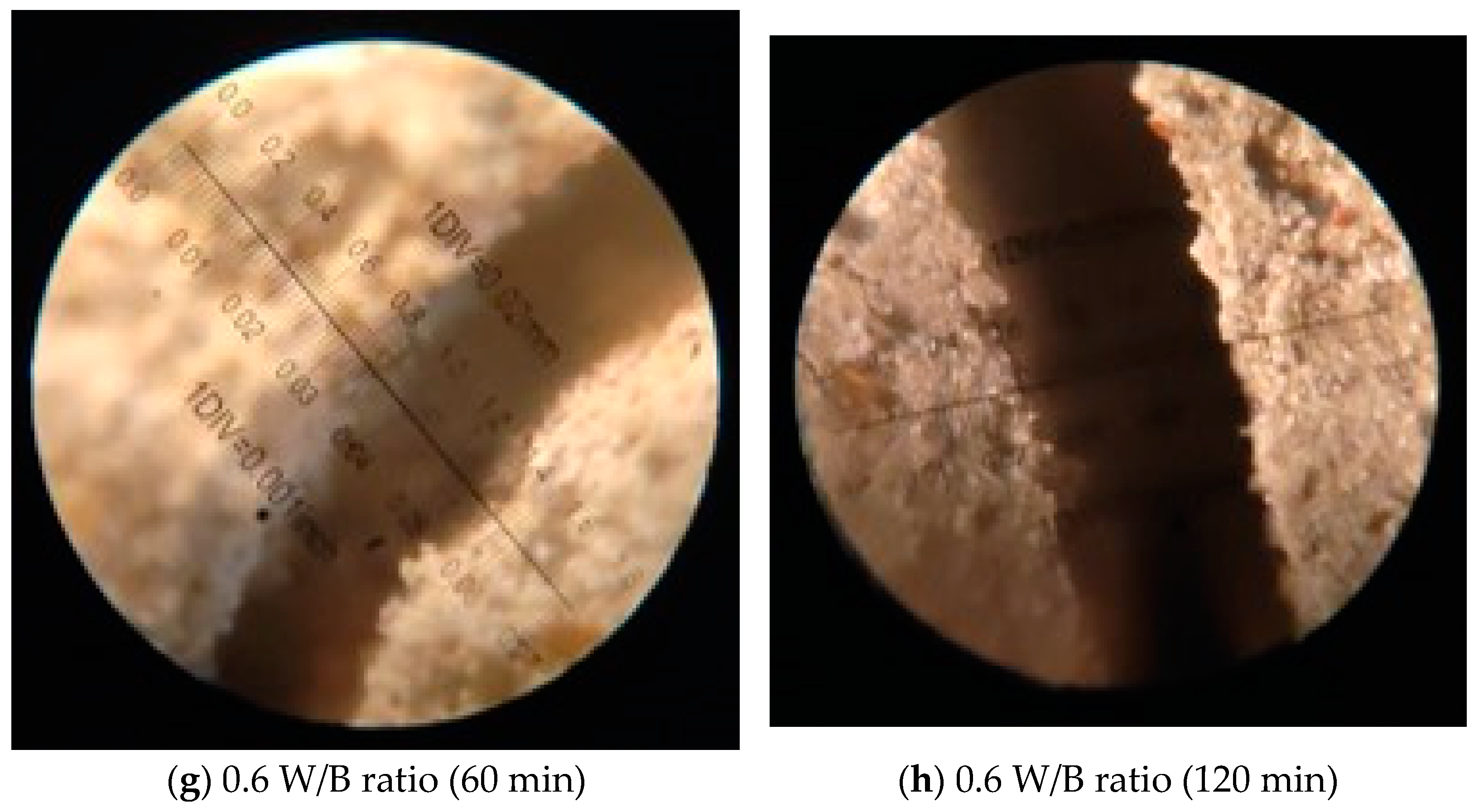

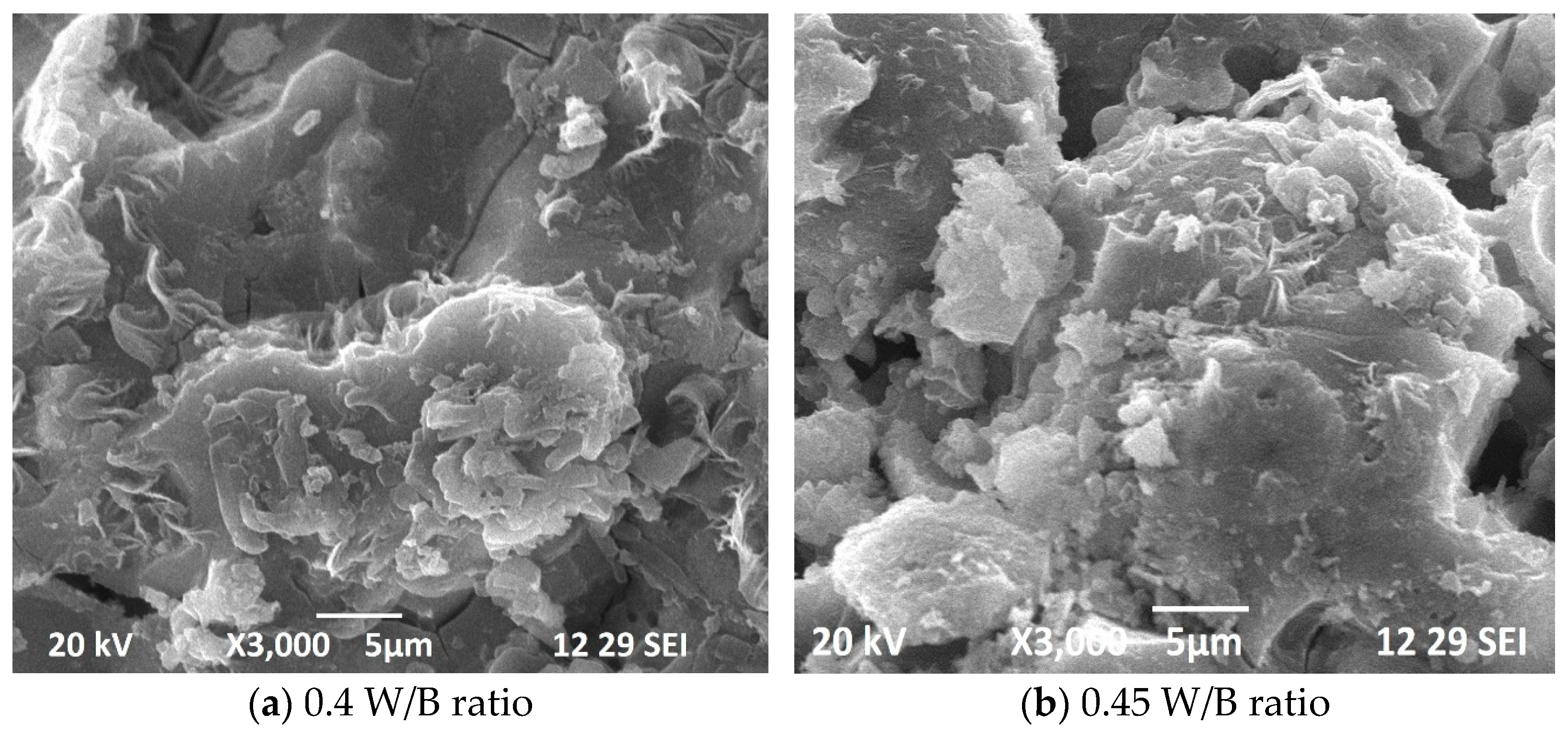
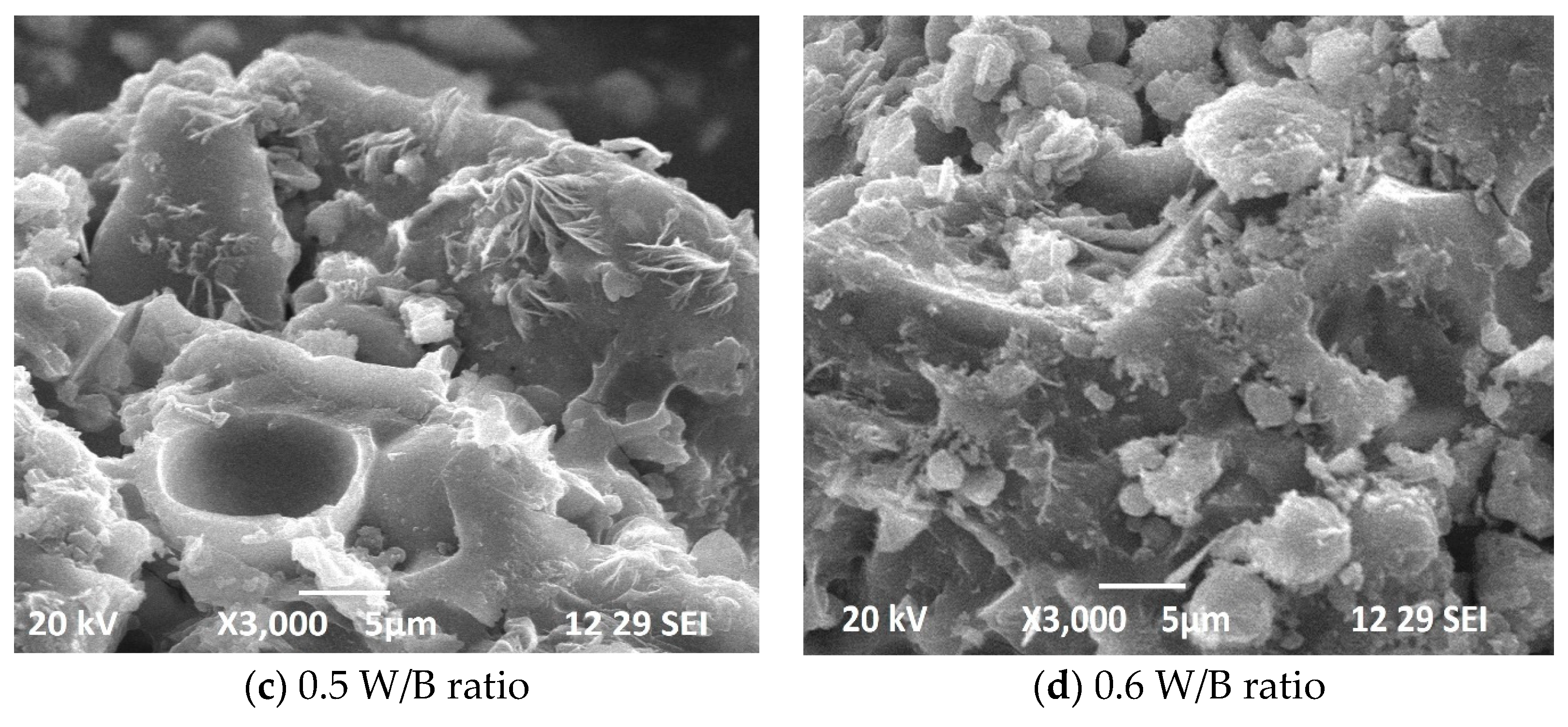
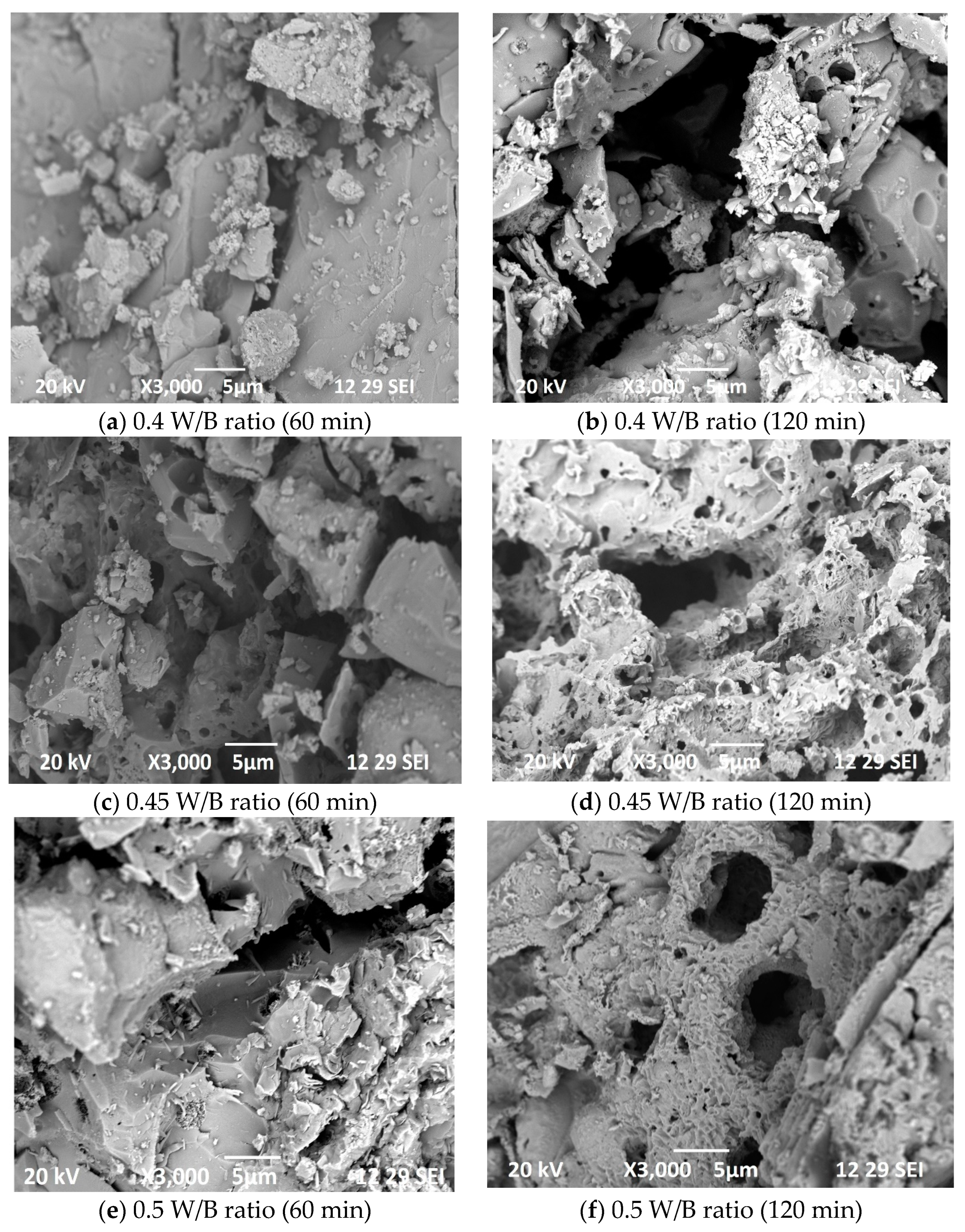
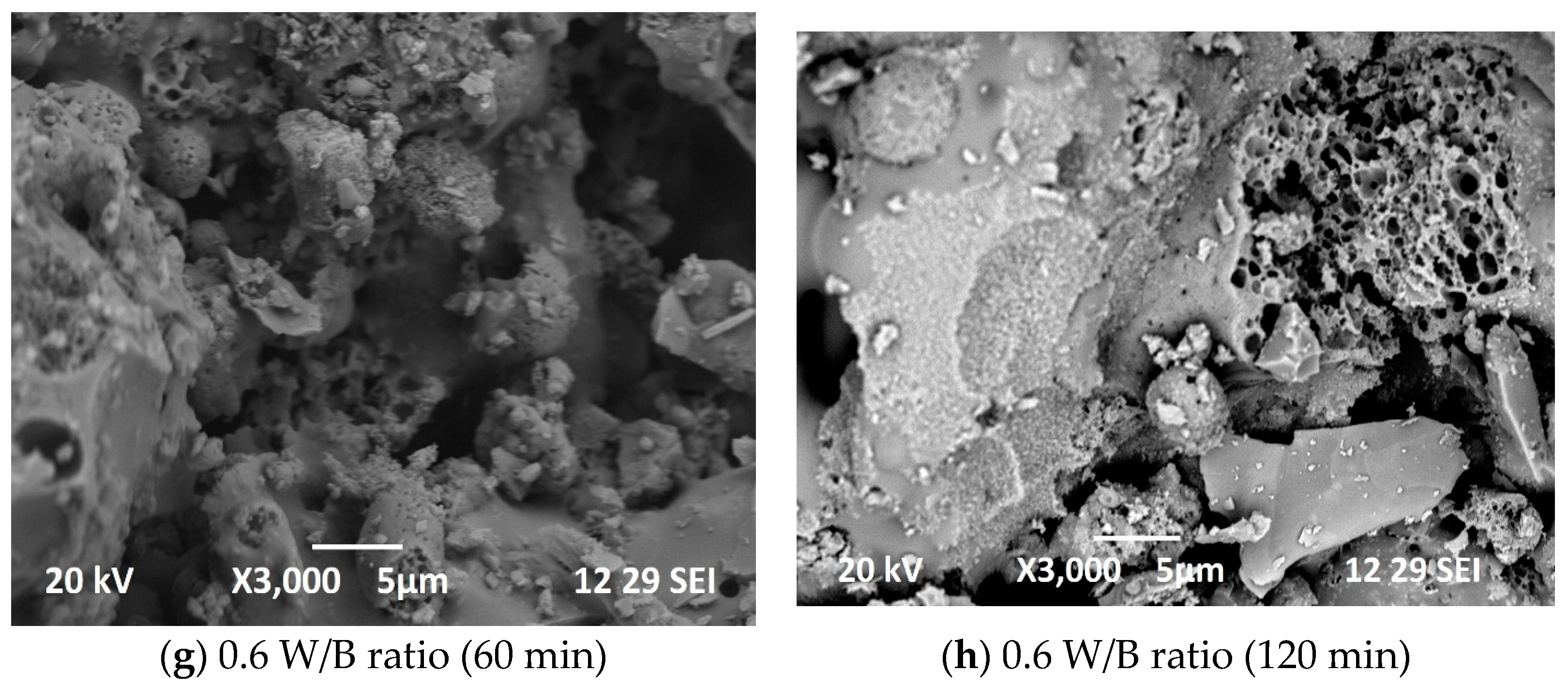
| Oxides | FA (%) | GGBS (%) |
|---|---|---|
| SiO2 | 61.2 | 42.4 |
| Al2O3 | 26.9 | 13.2 |
| Fe2O3 | 6.21 | 1.12 |
| Cao | 1.91 | 41.2 |
| MgO | 0.29 | 1.3 |
| Na2O | 0.58 | 0.3 |
| K2O | 1.21 | 0.7 |
| Ti | 0.4 | - |
| LOI | 0.89 | 0.52 |
| Sl.no | Target CS (MPa) | Minimum Binder Material Content (kg) | Maximum Total Water-Binder Material Ratio |
| 1 | 10 | 280 | 0.6 |
| 2 | 20 | 320 | 0.5 |
| 3 | 30 | 350 | 0.45 |
| 4 | 40 | 400 | 0.4 |
| Mix Type | FA | GGBS | Fine Aggregate | Coarse Aggregate | Na2SiO3 | NaOH |
|---|---|---|---|---|---|---|
| (kg/m3) | ||||||
| M40 | 280 | 120 | 803 | 1156 | 51.84 | 34.56 |
| M30 | 245 | 105 | 750 | 1080 | 48 | 32 |
| M20 | 224 | 96 | 653 | 970 | 45.32 | 30.21 |
| M10 | 196 | 84 | 450 | 650 | 43.44 | 28.96 |
| Grades | Sample 1 | Sample 2 | Sample 3 | Mean | SD | CoV (%) |
|---|---|---|---|---|---|---|
| M10 | 19.8 | 20.8 | 21.2 | 20.60 | 0.72 | 0.04 |
| M20 | 27.4 | 26.05 | 28.9 | 27.45 | 1.43 | 0.05 |
| M30 | 33.71 | 33.89 | 35.3 | 34.30 | 0.87 | 0.03 |
| M40 | 42.06 | 43.1 | 42.65 | 42.60 | 0.52 | 0.01 |
| Grades | Duration | Sample 1 | Sample 2 | Sample 3 | Mean | SD | CoV (%) |
|---|---|---|---|---|---|---|---|
| M10 | 30 min | 13.21 | 12.14 | 12.98 | 12.78 | 0.56 | 0.04 |
| M20 | 21.52 | 20.7 | 22.63 | 21.62 | 0.97 | 0.04 | |
| M30 | 24.98 | 25.06 | 26.3 | 25.45 | 0.74 | 0.03 | |
| M40 | 25.88 | 26.94 | 27.9 | 26.91 | 1.01 | 0.04 | |
| M10 | 60 min | 6.5 | 7.2 | 8.1 | 7.27 | 0.80 | 0.11 |
| M20 | 10.5 | 10.8 | 11.75 | 11.02 | 0.65 | 0.06 | |
| M30 | 10.89 | 12.45 | 13.2 | 12.18 | 1.18 | 0.10 | |
| M40 | 13.72 | 14.05 | 14.21 | 13.99 | 0.25 | 0.02 | |
| M10 | 90 min | 1.98 | 2.65 | 2.57 | 2.40 | 0.37 | 0.15 |
| M20 | 6.2 | 5.8 | 7.1 | 6.37 | 0.67 | 0.10 | |
| M30 | 10.5 | 10.2 | 11.2 | 10.63 | 0.51 | 0.05 | |
| M40 | 10.8 | 12.1 | 11.5 | 11.47 | 0.65 | 0.06 | |
| M10 | 120 min | - | - | - | - | - | - |
| M20 | 3.5 | 3.1 | 2.9 | 3.17 | 0.31 | 0.10 | |
| M30 | 6.89 | 8.8 | 9.2 | 8.30 | 1.23 | 0.15 | |
| M40 | 10.2 | 8.6 | 8.9 | 9.23 | 0.85 | 0.09 |
| Ref. | Type of Concrete | Binder Medium | Temperature (°C) |
|---|---|---|---|
| [64] | GPC | Fly Ash | 400, 600 and 800 °C |
| Increase in the activator to binder ratio from 0.5 to 0.7 increased the weight loss by an average of 1% at each of the temperatures of 400 °C, 600 °C and 800 °C, respectively. Increasing the activator ratio from 1.5 to 3.5 decreased weight loss on average by 0.4% at 400 °C, 0.9% at 600 °C and 0.7% at 800 °C. Increase in the activator ratio, compressive strength decreased from 13% to 31% for at 400 °C, from 45% to 53% at 600 °C, and around 80% at 800 °C | |||
| [65] | Fiber reinforced GPC | Fly Ash and GGBS | 200, 500 and 800 °C |
| The residual compressive strength of GPC at 200 was greater than its original strength. there was a strength enhancement of 11.1% which is ascribed to the secondary geopolymerization. After exposure to 500 and 800 °C, all the concrete specimens showed an obvious decline in compressive strength | |||
| [66] | Lightweight geopolymer concrete | Fly Ash and GGBS | 100 °C to 800 °C |
| Heating the concrete samples to 100 °C contributed to increasing the compressive strength of geopolymer and cement concrete. Raising the heating temperature to above 100 °C led to a loss in the compressive strength of the cement concrete and geopolymer. The behavior of the compressive strength of geopolymer concrete was compatible with cement concrete under the heating influence of the entire temperatures | |||
| [67] | Ultra-high performance geopolymer concrete (UHPGC) | GGBS, Silica fume, waste glass (WG) and waste ceramic (WC) | 200–800 °C |
| The residual strength of UHPGC containing WG varied from 98% to 97%, 59–63%, and 27–32% after being subjected to 300, 600, and 800 °C, respectively. While WC samples had residual strengths varying from 86% to 83%, 51–45%, and 24–18%, respectively. | |||
| [68] | GPC | Metakaolin | 200 °C, 400 °C, and 600 °C |
| Compressive strength was lost at a higher rate when temperature increased from ambient to 200 °C; however, the rate of reduction was lower when temperature increased from 200 °C to 400 °C and from 400 °C to 600 °C. Also, the residual compressive strength varied from 56% to 63%, 38% to 51%, and 28% to 34% after exposure to 200 °C, 400 °C, and 600 °C | |||
| [69] | GPC | Fly ash, metakaolin, and slag | 100 °C to 700 °C |
| GPC mixes revealed the strength losses after being subjected to temperatures between 200 and 700 °C due to the thermal incompatibility between geopolymer matrix and aggregates resulting in debonding and internal cracks. | |||
| [70] | GPC | Fly ash and GGBS | 100 °C to 800 °C |
| When exposed to elevated temperatures, the compressive strength of alkali activated fly ash (AAF) shows a sharp rise before 200 °C, and then largely maintains the strength gain effect from 200 to 800 °C with a 150.3% improvement recorded after 800 °C exposure | |||
| Present | GPC | Fly ash and GGBS | 821 °C, 925 °C, 986 °C and 1029 °C. |
| Most of the past studies deal with the concrete subjecting to random temperature exposure. This means that in previous studies, researchers subjected concrete samples to varying and unspecified temperature conditions, possibly simulating fire or heat exposure, but without adhering to a specific standardized guideline. The temperature conditions might have been randomly chosen or not based on a recognized industry standard. Whereas the present study focuses on the use of ISO 834 [30] standard guidelines for heating the concrete samples. In contrast to the past studies, the current study is designed to follow the ISO 834 [30] standard guidelines. ISO 834 [30] is an internationally recognized standard that provides guidelines for simulating fire exposure on building elements, including concrete, in a controlled and consistent manner. This standard specifies a heating curve that represents the time-temperature relationship of a real building fire. In this case, the concrete specimens were exposed to real-time fire exposure as set by ISO 834. The temperature conditions applied to the concrete specimens in the study closely mimic the heat that would be experienced by real building elements during a fire, following a specific time-temperature profile. The findings from this investigation underscore the vulnerability of geopolymer concrete, particularly in the M40 and M10 grades, to the adverse effects of temperature exposure. The study highlights a clear pattern of diminishing compressive strength with longer durations of elevated temperature exposure, focuses on the importance of considering these factors in the design and application of geopolymer concrete in scenarios where temperature fluctuations are anticipated. | |||
Disclaimer/Publisher’s Note: The statements, opinions and data contained in all publications are solely those of the individual author(s) and contributor(s) and not of MDPI and/or the editor(s). MDPI and/or the editor(s) disclaim responsibility for any injury to people or property resulting from any ideas, methods, instructions or products referred to in the content. |
© 2023 by the authors. Licensee MDPI, Basel, Switzerland. This article is an open access article distributed under the terms and conditions of the Creative Commons Attribution (CC BY) license (https://creativecommons.org/licenses/by/4.0/).
Share and Cite
Kanagaraj, B.; Anand, N.; Andrushia, D.; Kodur, V. Residual Properties of Geopolymer Concrete for Post-Fire Evaluation of Structures. Materials 2023, 16, 6065. https://doi.org/10.3390/ma16176065
Kanagaraj B, Anand N, Andrushia D, Kodur V. Residual Properties of Geopolymer Concrete for Post-Fire Evaluation of Structures. Materials. 2023; 16(17):6065. https://doi.org/10.3390/ma16176065
Chicago/Turabian StyleKanagaraj, Balamurali, Nammalvar Anand, Diana Andrushia, and Venkatesh Kodur. 2023. "Residual Properties of Geopolymer Concrete for Post-Fire Evaluation of Structures" Materials 16, no. 17: 6065. https://doi.org/10.3390/ma16176065
APA StyleKanagaraj, B., Anand, N., Andrushia, D., & Kodur, V. (2023). Residual Properties of Geopolymer Concrete for Post-Fire Evaluation of Structures. Materials, 16(17), 6065. https://doi.org/10.3390/ma16176065







